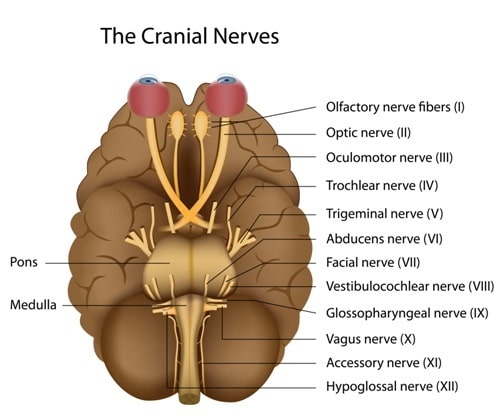
12 pairs of cranial nerves: What are they and what are their functions?
12 pairs of cranial nerves enable us to perform our daily routine in a comfortable and efficient way, as they take part of the information of our senses to the brain and the brain to some of our muscles and viscera. Here is a small guide to know a little more about what are the cranial nerves, their anatomy, their classification and their function.
What are the 12 pairs of cranial nerves?
The cranial nerves are 12 pairs of nerves that pass through small holes at the base of the skull. These nerves are responsible for carrying information and connecting the brain to different parts of the body (sensory organs, motors, muscles, organs, etc.)
Our brain is in continuous communication through the spinal cord with almost all of the brain nerves. That is, if for example, we notice that we are stepping on something soft, that signal is transmitted through our leg nerves until reaching the spinal cord and from there taking over until that signal reaches the brain (afferent order) and there the order is given to keep stepping because it’s pleasant. This new order to keep stepping, will “descend” (efferent order) from our brain, passing through the spinal cord and will reach our feet again through the same nerve fibers as before.
In the specific case of the cranial nerves, what makes them unique and special is that they emerge directly from the brain without passing through the spinal cord. That is, they are located in the lower part of the brain and go through holes at the base of the skull to reach their destination. Interestingly, these nerves are not only directed to areas such as the head but also extend to other parts such as the neck or the thoracic area (vagus nerve).
Thus, it could be said, that the cranial nerves are part the nervous system. To be more specific, they are part of the peripheral nervous system that relates the brain to the cranial and cervical structures in an afferent direction, and sensory, sensorial, motor and vegetative in an efferent direction. The rest of the afferent and efferent connections between the central nervous system and the body is done through the spinal nerves.
Classification of the 12 pairs of cranial nerves
Each cranial nerve is paired and is present on both sides. There are twelve cranial nerves pairs, which are assigned Roman numerals I–XII, sometimes also including cranial nerve zero. There are XII cranial nerves on the left hemisphere of the brain and exactly the same on the right hemisphere.
The cranial nerves numbering is based on the order in which they emerge from the brain and the function they perform.
12 pairs of cranial nerves according to their position
As shown in the image above, the 12 pairs of cranial nerves have an associated Roman numeral. These numbers range from 1 to 12 corresponding in each case to the pair in question.
The cranial nerves that emerge:
- Above the brain stem are pair I and pair II
- From the midbrain are pair III and IV
- From the pons (or Varolius Bridge) are the cranial nerves V, VI, VII and VIII.
- From the medulla oblongata the cranial pairs IX, X, XI, and XII.
12 pairs of cranial nerves according to their function
- Sensitive function: formed by the cranial nerves I, II, VI and VIII.
- Associated with ocular mobility and eyelids: cranial nerve III, IV and VI.
- Related to neck and tongue muscle activation: cranial nerves XI and XII.
- Considered mixed function: cranial pairs V, VII, IX, and X.
- As parasympathetic fibers: III, VII, IX, and X.
12 pairs of cranial nerves and their function
Each cranial nerves has a specific function. The next image shows how this person’s head is portrayed through numbers according to the cranial nerve functions. Would you dare to say what function each cranial pair has according to its number in the drawing?
Before starting, it’s important to point out the order that this explanation will have will be according to the corresponding Roman number assigned to the cranial nerve.
I- Olfactory Nerve
It’s the first of the 12 pairs of cranial nerves. It’s a sensory nerve, in charge of transmitting olfactory stimuli from the nose to the brain. Its actual origin is given by the cells of the olfactory bulb. It is the shortest cranial pair of all.
II- Optic Nerve
This cranial pair is the second of the 12 pairs of cranial nerves and it is responsible for conducting visual stimuli from the eye to the brain. It is made of axons from the ganglion cells of the retina, that take the information of the photoreceptors to the brain, where later it will be integrated and interpreted. It emerges in the diencephalon.
III- Oculomotor
This cranial nerve is also known as the common ocular motor nerve. It is the third of the 12 pairs of cranial nerves. It controls eye movement and is also responsible for pupil size. It originates in the midbrain.
IV- Trochlear
This nerve has a motor and somatic functions that are connected to the superior oblique muscle of the eye, being able to make the eyeballs move and rotate. Its nucleus also originates in the mesencephalon as well as the oculomotor nerve. It is the fourth of the 12 pairs of cranial nerves.
V- Trigeminal
It is a mixed cranial nerve (sensitive, sensory and motor), being the largest of all cranial nerves, it is the fifth of the 12 pairs of cranial nerves. Its function is to carry sensitive information to the face, to convey information for the chewing process. The sensory fibers convey sensations of touch, pain, and temperature from the front of the head including the mouth and also from the meninges.
VI- Abducent
It is also known as the external ocular motor cranial nerve and it is the sixth of the 12 pairs of cranial nerves. It is a cranial motor pair, responsible for transmitting the motor stimuli to the external rectus muscle of the eye and therefore allowing the eye to move to the opposite side from where we have the nose.
VII- Facial or Intermediate
This is another mixed cranial pair since it consists of several nerve fibers that perform different functions, like ordering the muscles of the face to create facial expressions and also send signals to the salivary and lacrimal glands. On the other hand, it collects taste information through the tongue. It is the seventh of the 12 pairs of cranial nerves.
VIII- Vestibulo-Cochlear
It is a sensory cranial nerve. It is also known as the auditory and vestibular nerve, thus forming vestibulocochlear. He is responsible for balance and orientation in space and auditory function. It is the eighth of the 12 pairs of cranial nerves.
IX-Glossopharyngeal
It is a nerve whose influence lies in the tongue and pharynx. It collects information from the taste buds (tongue) and sensory information from the pharynx. It leads orders to the salivary gland and various neck muscles that help with swallowing. It also monitors blood pressure. It is the ninth of the 12 pairs of cranial nerves.
X-Vagus
This nerve is also known as pneumogastric. It emerges from the medulla oblongata and supplies nerves to the pharynx, esophagus, larynx, trachea, bronchi, heart, stomach and liver. Like the previous nerve, it influences the action of swallowing but also in sending and transmitting signals to our autonomous system, to help the regulate activation and control stress levels or send signals directly to our sympathetic system. It is the tenth of the 12 pairs of cranial nerves.
XI-Accessory
This cranial pair is named the spinal nerve. It is a motor nerve and could be understood as one of the most “pure”. It governs movements of the head and shoulders by supplying the sternocleidomastoid and trapezius muscles in the (anterior and posterior) regions of the neck. The spinal nerve also allows us to throw our heads back. Thus, we would say that it intervenes in the movements of the head and the shoulders. It is the eleventh of the 12 pairs of cranial nerves.
XII-Hypoglossal
It is a motor nerve which, like the vagus and glossopharyngeal, is involved in tongue muscles, swallowing and speech. It is the twelveth of the 12 pairs of cranial nerves.
Before ending, it would be good to take a look at this video because it brings together the basic ideas outlined in this article!
Now that you know the names and functions of the pairs of cranial nerves. You can put them to the test by doing these exercises:
Olfactory Nerve (I) Gather some items with distinctive smells (for example, cloves, lemon, chocolate or coffee) record what the item is and the strength of the odor.
Optic Nerve (II) Make a Snellen Chart try to read the lines at various distances away from the chart.
Oculomotor Nerve (III), Trochlear Nerve (IV) and Abducens Nerve (VI) follow your finger sideways or up and down.
Check the pupillary response (oculomotor nerve): look at the diameter of your partner’s eyes in dim light and also in bright light. Check for differences in the sizes of the right and left pupils.
Trigeminal Nerve (V) Move your jaw up and down as if you were chewing gum.
Facial Nerve (VII) The motor part of the facial nerve can be tested by smiling or frowning or make funny faces. The sensory part of the facial nerve is responsible for taste on the front part of the tongue. You could try a few drops of sweet or salty water.
Vestibulocochlear Nerve (VIII) Although the vestibulocochlear nerve is responsible for hearing and balance, we will only test the hearing portion of the nerve here. Have your partner close his or her eyes and determine the distance at which he or she can hear the ticking of a clock or stopwatch.
Glossopharyngeal Nerve (IX) and Vagus Nerve (X) Have your partner drink some water and observe the swallowing reflex.
Spinal Accessory Nerve (XI) To test the strength of the muscles used in head movement, put you hands on the sides of your partner’s head. Tell your partner to move his or her head from side to side. Apply only light pressure when the head is moved.
Hypoglossal Nerve (XII) Move your tongue from side to side.
You can always test your cranial nerves knowledge here.
This article is originally in Spanish written by Tania Pérez Calleja, translated by Alejandra Salazar.












